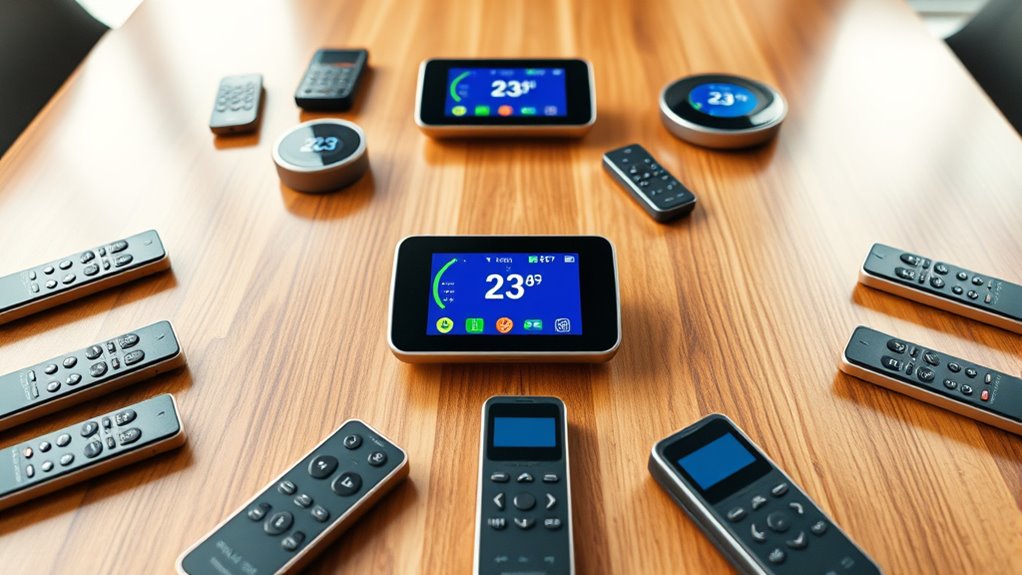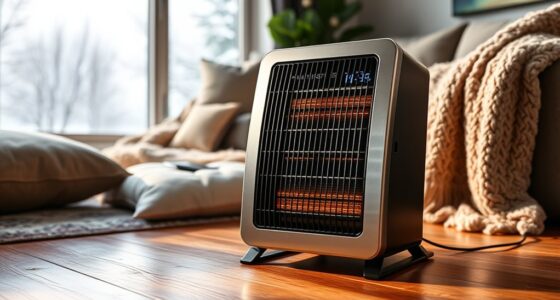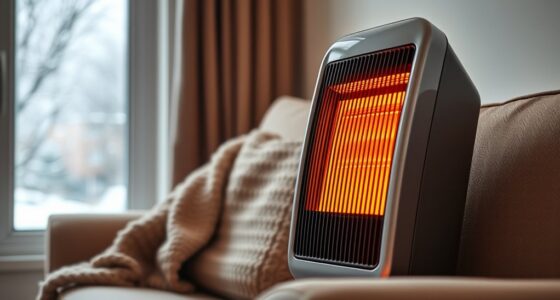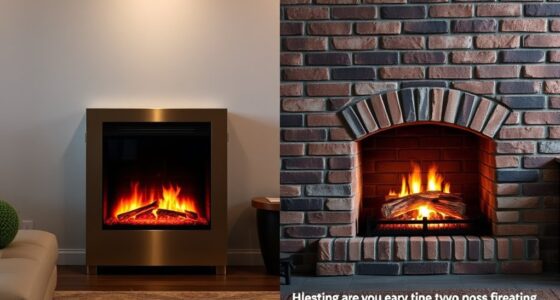The Complete Thermostats and Remotes Overview Playbook guides you through how smart thermostats and remote controls work together to boost home comfort and save energy. You’ll discover how these systems adjust temperatures automatically, respond to voice commands, and sync with other smart devices. With remote access, you can manage your home’s climate from anywhere. Keep exploring to uncover more tips on optimizing your smart home for efficiency and convenience.
Key Takeaways
- Integration of thermostats with remote controls and smart devices enhances home comfort and energy management.
- Smart thermostats analyze habits and automate adjustments to optimize energy use and reduce costs.
- Remote controls and voice commands provide flexible, convenient climate management from anywhere.
- Compatibility with other smart home devices enables synchronized automation for increased efficiency.
- These systems improve convenience, savings, and sustainability through advanced features and automation.
Smart Thermostats and Remote Control Integration

Have you ever wondered how thermostats and remotes work together to keep your home comfortable? It’s a fascinating dance of technology that guarantees your living space stays just right without wasting energy. When you think about smart home integration, it’s clear that modern thermostats don’t just control temperature—they connect seamlessly with your devices, apps, and voice assistants. This integration allows you to adjust your thermostat remotely, set schedules, and even receive alerts about energy consumption. The result? Enhanced convenience and smarter energy management, all from your smartphone or tablet.
Energy saving features are at the heart of these advanced systems. When paired with remote controls, smart thermostats can analyze your habits and automatically adjust settings to optimize energy use. For instance, if you typically turn the heat down at night or leave the house during the day, your system learns these patterns and makes adjustments without you lifting a finger. Many models can detect when you’re away and automatically switch to an energy-efficient mode, preventing unnecessary heating or cooling. This not only reduces your utility bills but also minimizes your environmental footprint.
Smart thermostats learn your habits and automatically switch to energy-efficient modes, saving money and reducing environmental impact.
Using a remote to control your thermostat offers flexibility and precision. Whether you’re lounging on the couch or away from home, you can change the temperature settings instantly. With smart home integration, you can even set up routines—like lowering the temperature during work hours or increasing it before you arrive home. Voice commands through Alexa, Google Assistant, or other smart assistants further streamline this process, making it so effortless that you might forget you’re even controlling your home environment.
The compatibility of thermostats with various smart home devices is another advantage. You can synchronize your thermostat with other systems, such as smart blinds or window sensors, to create a fully automated environment. For example, when a sensor detects sunlight heating a room, your thermostat can respond by reducing cooling, saving energy without sacrificing comfort.
Ultimately, the combination of thermostats and remotes—especially when integrated with smart home technology—empowers you to manage your home’s climate intelligently. You’re not just adjusting settings; you’re actively participating in conserving energy while maintaining comfort. With features like remote access, automation routines, and energy-saving modes, these systems make it easier than ever to keep your home cozy, cost-efficient, and environmentally friendly. It’s a smart investment that delivers convenience, savings, and peace of mind, all from the palm of your hand. Additionally, color accuracy plays a significant role in ensuring your home display screens deliver vibrant and true-to-life visuals, enhancing your overall experience.
Frequently Asked Questions
How Do I Troubleshoot Connectivity Issues With My Smart Thermostat?
To troubleshoot connectivity issues with your smart thermostat, start by checking your Wi-Fi signal strength and ensuring your device is within range. Next, perform a sensor calibration if temperatures seem off, and check for firmware updates; outdated firmware can cause connection problems. Restart your thermostat and router, and re-establish the connection. If issues persist, reset your thermostat to factory settings and reconnect to your Wi-Fi network.
Are There Compatibility Concerns With Specific Home Automation Systems?
You might think your smart thermostat will seamlessly blend into your home automation system, but compatibility concerns are real. System integration can be tricky, and device interoperability isn’t always guaranteed. Some thermostats work perfectly with certain platforms, while others throw a fit. Double-check the manufacturer’s specifications and supported systems before buying. Otherwise, your thermostat might feel like an outsider at the smart home party, despite your best efforts to include it.
What Are the Security Risks Associated With Remote Thermostat Control?
Remote thermostat control can expose you to cybersecurity vulnerabilities, such as hacking or unauthorized access. If your system isn’t properly secured, hackers could manipulate your settings, causing comfort issues or energy waste. Privacy concerns also arise if personal data is stored or transmitted insecurely. To safeguard yourself, ensure your Wi-Fi network has strong passwords, update firmware regularly, and enable two-factor authentication when available.
How Can I Optimize Energy Savings Using Remote Thermostat Features?
You can optimize energy savings by leveraging remote thermostat features like scheduling and temperature adjustments. Set schedules to match your routine, reducing unnecessary energy consumption when you’re away or asleep. Use app controls to fine-tune your settings easily, ensuring your home stays comfortable without wasting energy. Regularly review and adjust your schedules based on season changes or lifestyle shifts to maximize efficiency and save on energy costs.
What Maintenance Is Required for Long-Term Remote Control Functionality?
Maintain your remote control’s mastery by regularly replacing batteries to prevent power problems and guarantee consistent connectivity. Keep the device current by performing firmware updates, which enhance features and fix bugs. Check for any signs of damage, clean the screen gently, and store it in a safe, dry spot. This simple, steady stewardship guarantees long-term functionality and keeps your remote running reliably, ready for your every command.
Conclusion
By now, you see how smart thermostats and remotes can transform your home comfort. Did you know that using these devices can reduce heating and cooling costs by up to 23%? That’s not just savings—it’s peace of mind and a smarter way to live. Embrace the technology, take control, and enjoy a more efficient, comfortable home every day. Your future self will thank you for making this simple, impactful change.









